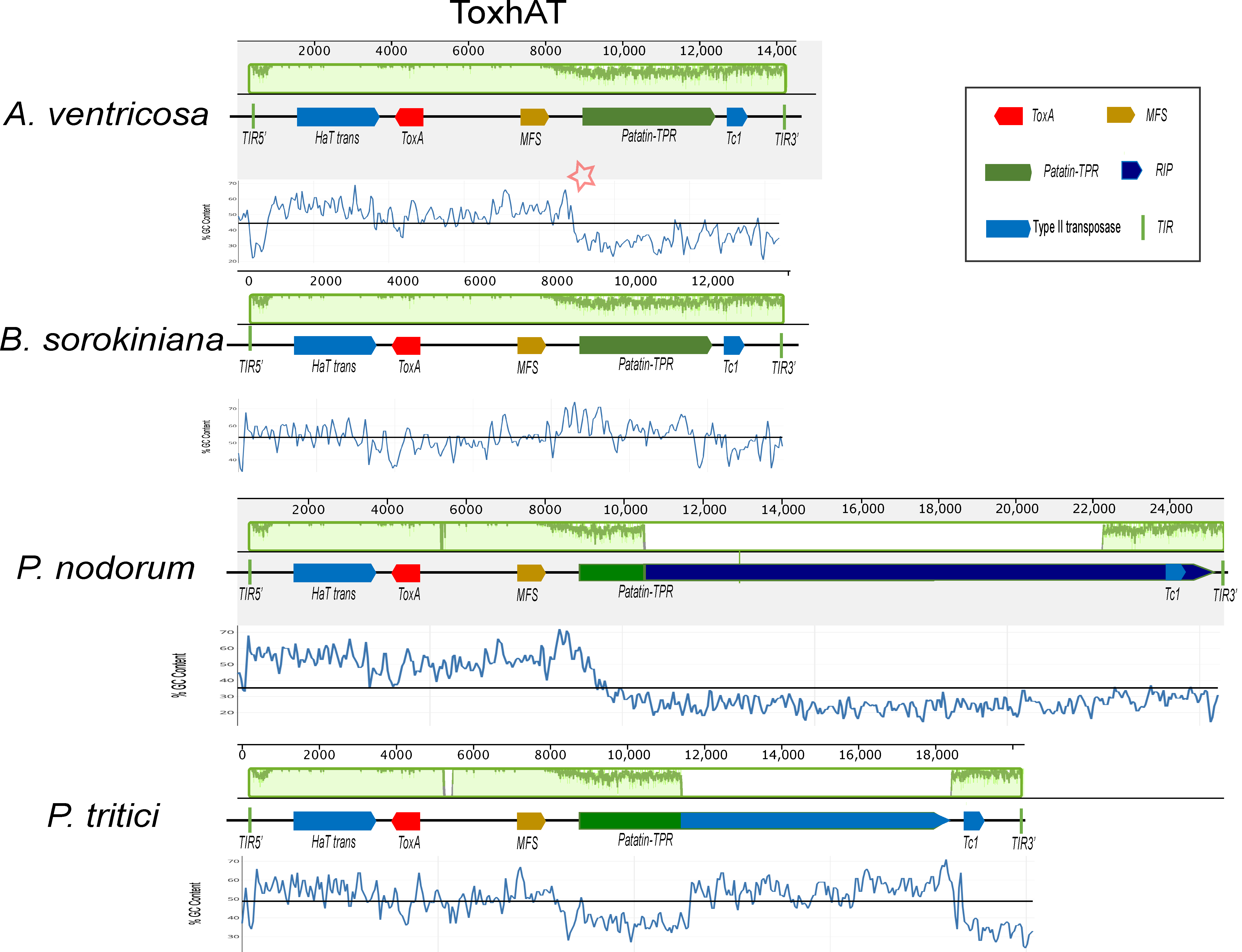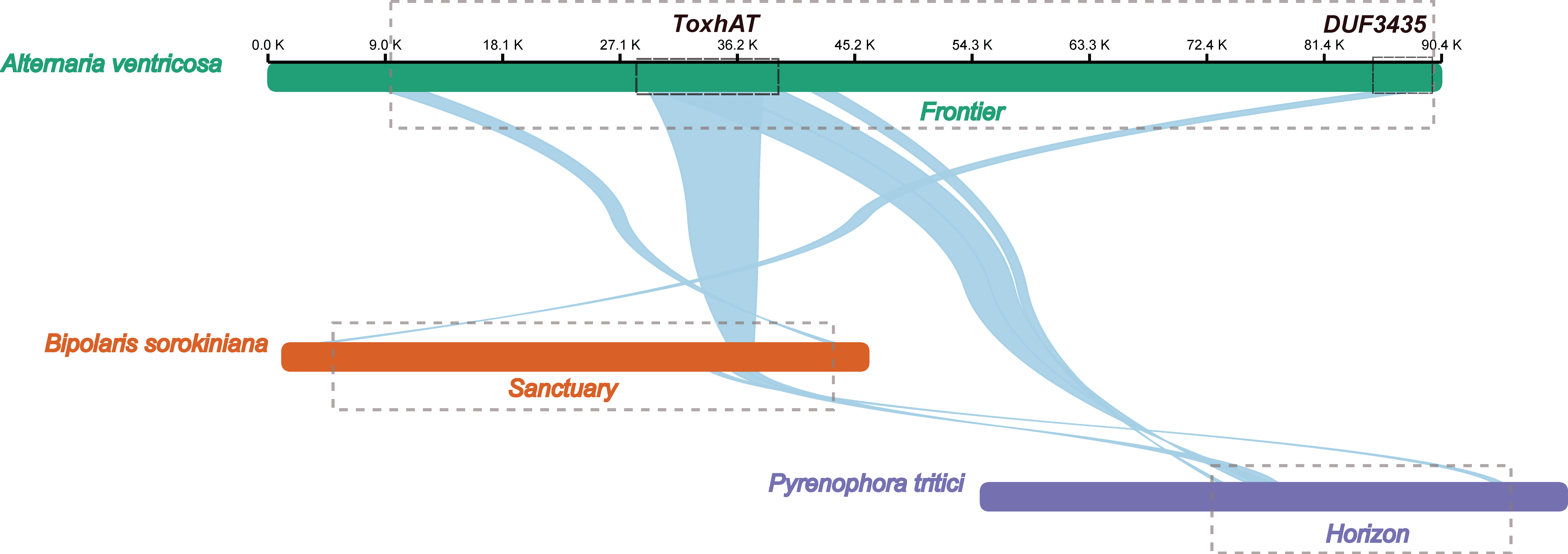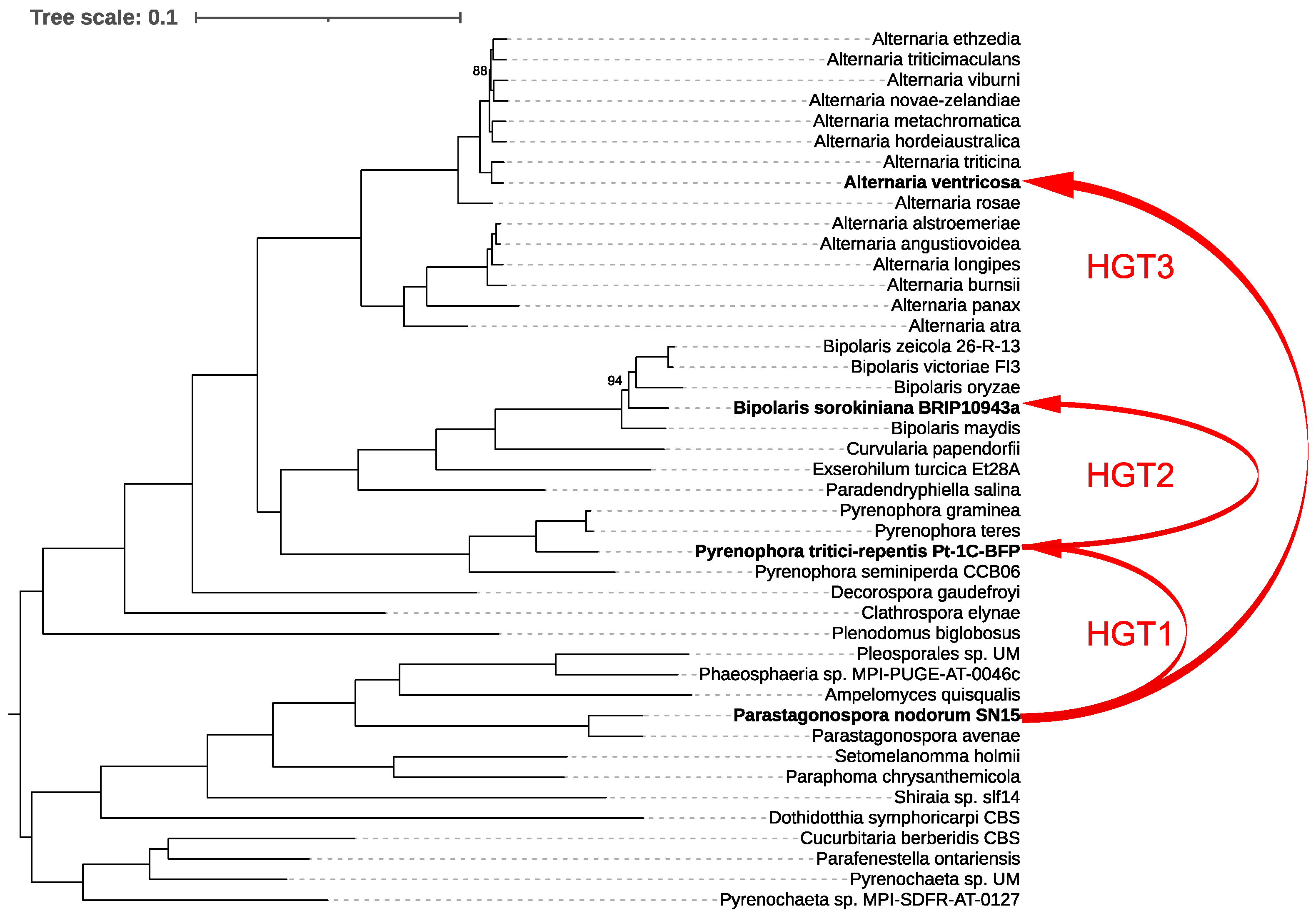Discovery of a New Starship Transposon Driving the Horizontal Transfer of the ToxA Virulence Gene in Alternaria ventricosa
Abstract
1. Introduction
2. Materials and Methods
2.1. Dataset
2.2. Gene Prediction and Annotation
2.3. Sequence Comparisons
2.4. Phylogenetic Tree of Species and HGT Detection
3. Results
3.1. A Homolog of ToxA in the A. ventricosa Genome
3.2. The 14 kbp ToxhAT Transposon in the A. ventricosa Genome
3.3. Starship Elements Present in the A. ventricosa Genome
3.4. Interspecies HGT Events of ToxA
4. Discussion
Supplementary Materials
Author Contributions
Funding
Data Availability Statement
Conflicts of Interest
References
- Huang, J. Horizontal Gene Transfer in Eukaryotes: The Weak-Link Model. Bioessays 2013, 35, 868–875. [Google Scholar] [CrossRef] [PubMed]
- Keeling, P.J.; Palmer, J.D. Horizontal Gene Transfer in Eukaryotic Evolution. Nat. Rev. Genet. 2008, 9, 605–618. [Google Scholar] [CrossRef] [PubMed]
- Zhang, Q.; Chen, X.; Xu, C.; Zhao, H.; Zhang, X.; Zeng, G.; Qian, Y.; Liu, R.; Guo, N.; Mi, W.; et al. Horizontal Gene Transfer Allowed the Emergence of Broad Host Range Entomopathogens. Proc. Natl. Acad. Sci. USA 2019, 116, 7982–7989. [Google Scholar] [CrossRef] [PubMed]
- Cao, J.; Liu, F.; Liu, S.; Wang, J.; Zhu, B.; Shi, Y.; Gao, G.F. Identification of Antibiotic Resistance Genes and Associated Mobile Genetic Elements in Permafrost. Sci. China Life Sci. 2021, 64, 2210–2213. [Google Scholar] [CrossRef] [PubMed]
- Liu, F.; Zhu, Y.; Yi, Y.; Lu, N.; Zhu, B.; Hu, Y. Comparative Genomic Analysis of Acinetobacter Baumannii Clinical Isolates Reveals Extensive Genomic Variation and Diverse Antibiotic Resistance Determinants. BMC Genom. 2014, 15, 1163. [Google Scholar] [CrossRef] [PubMed]
- Marcet-Houben, M.; Gabaldón, T. Acquisition of Prokaryotic Genes by Fungal Genomes. Trends Genet. 2010, 26, 5–8. [Google Scholar] [CrossRef] [PubMed]
- Shen, X.-X.; Opulente, D.A.; Kominek, J.; Zhou, X.; Steenwyk, J.L.; Buh, K.V.; Haase, M.A.B.; Wisecaver, J.H.; Wang, M.; Doering, D.T.; et al. Tempo and Mode of Genome Evolution in the Budding Yeast Subphylum. Cell 2018, 175, 1533–1545.e20. [Google Scholar] [CrossRef]
- Aleksander, M. The Interkingdom Horizontal Gene Transfer in 44 Early Diverging Fungi Boosted Their Metabolic, Adaptive, and Immune Capabilities. Evol. Lett. 2024, 8, 526–538. [Google Scholar]
- Liu, F.; Wang, S.-H.; Cheewangkoon, R.; Zhao, R.-L. Uneven Distribution of Prokaryote-Derived Horizontal Gene Transfer in Fungi: A Lifestyle-Dependent Phenomenon. mBio 2024, 16, e0285524. [Google Scholar] [CrossRef] [PubMed]
- Liu, F.; Ma, X.-B.; Han, B.; Wang, B.; Xu, J.-P.; Cao, B.; Ling, Z.-L.; He, M.-Q.; Zhu, X.-Y.; Zhao, R.-L. Pan-Genome Analysis Reveals Genomic Variations during Enoki Mushroom Domestication, with Emphasis on Genetic Signatures of Cap Color and Stipe Length. J. Adv. Res. 2024; in press. [Google Scholar] [CrossRef]
- Bucknell, A.H.; McDonald, M.C. That’s No Moon, It’s a Starship: Giant Transposons Driving Fungal Horizontal Gene Transfer. Mol. Microbiol. 2023, 120, 555–563. [Google Scholar] [CrossRef]
- Gluck-Thaler, E.; Ralston, T.; Konkel, Z.; Ocampos, C.G.; Ganeshan, V.D.; Dorrance, A.E.; Niblack, T.L.; Wood, C.W.; Slot, J.C.; Lopez-Nicora, H.D.; et al. Giant Starship Elements Mobilize Accessory Genes in Fungal Genomes. Mol. Biol. Evol. 2022, 39, msac109. [Google Scholar] [CrossRef] [PubMed]
- Tuori, R.P.; Wolpert, T.J.; Ciuffetti, L.M. Purification and Immunological Characterization of Toxic Components from Cultures of Pyrenophora Tritici-Repentis. Mol. Plant Microbe Interact. 1995, 8, 41–48. [Google Scholar] [CrossRef] [PubMed]
- Ciuffetti, L.M.; Francl, L.J.; Ballance, G.M.; Bockus, W.W.; Lamari, L.; Meinhardt, S.W.; Rasmussen, J.B. Standardization of Toxin Nomenclature in the Pyrenophora Tritici-Repentis/Wheat Interaction. Can. J. Plant Pathol. 1998, 20, 421–424. [Google Scholar] [CrossRef]
- Friesen, T.L.; Stukenbrock, E.H.; Liu, Z.; Meinhardt, S.; Ling, H.; Faris, J.D.; Rasmussen, J.B.; Solomon, P.S.; McDonald, B.A.; Oliver, R.P. Emergence of a New Disease as a Result of Interspecific Virulence Gene Transfer. Nat. Genet. 2006, 38, 953–956. [Google Scholar] [CrossRef] [PubMed]
- McDonald, M.C.; Oliver, R.P.; Friesen, T.L.; Brunner, P.C.; McDonald, B.A. Global Diversity and Distribution of Three Necrotrophic Effectors in Phaeosphaeria Nodorum and Related Species. New Phytol. 2013, 199, 241–251. [Google Scholar] [CrossRef]
- McDonald, M.C.; Ahren, D.; Simpfendorfer, S.; Milgate, A.; Solomon, P.S. The Discovery of the Virulence Gene ToxA in the Wheat and Barley Pathogen Bipolaris Sorokiniana. Mol. Plant Pathol. 2017, 19, 432–439. [Google Scholar] [CrossRef]
- Ohm, R.A.; Feau, N.; Henrissat, B.; Schoch, C.L.; Horwitz, B.A.; Barry, K.W.; Condon, B.J.; Copeland, A.C.; Dhillon, B.; Glaser, F.; et al. Diverse Lifestyles and Strategies of Plant Pathogenesis Encoded in the Genomes of Eighteen Dothideomycetes Fungi. PLoS Pathog. 2012, 8, e1003037. [Google Scholar] [CrossRef] [PubMed]
- McDonald, M.C.; Taranto, A.P.; Hill, E.; Schwessinger, B.; Liu, Z.; Simpfendorfer, S.; Milgate, A.; Solomon, P.S. Transposon-Mediated Horizontal Transfer of the Host-Specific Virulence Protein ToxA between Three Fungal Wheat Pathogens. mBio 2019, 10, e01515-19. [Google Scholar] [CrossRef]
- Galagan, J.E.; Selker, E.U. RIP: The Evolutionary Cost of Genome Defense. Trends Genet. 2004, 20, 417–423. [Google Scholar] [CrossRef]
- Ghaderi, F.; Sharifnabi, B.; Javan-Nikkhah, M.; Brunner, P.C.; McDonald, B.A. SnToxA, SnTox1, and SnTox3 Originated in Parastagonospora Nodorum in the Fertile Crescent. Plant Pathol. 2020, 69, 1482–1491. [Google Scholar] [CrossRef]
- Bucknell, A.; Wilson, H.M.; Gonçalves Do Santos, K.C.; Simpfendorfer, S.; Milgate, A.; Germain, H.; Solomon, P.S.; Bentham, A.; McDonald, M.C. Sanctuary: A Starship Transposon Facilitating the Movement of the Virulence Factor ToxA in Fungal Wheat Pathogens. bioRxiv 2024. [Google Scholar] [CrossRef]
- Roberts, R.G.; Roberts, R.G. Two New Species of Alternaria from Pear Fruit. Mycotaxon 2007, 100, 159–167. [Google Scholar]
- Fadhil, W.F.; Al-Saadoon, A.H.; Al-Moussawi, F.M. New Records of Mycobiota Associated with Stored Wheat and Its By- Products in Iraq. Biodiversitas 2022, 23, 3099–3107. [Google Scholar] [CrossRef]
- Ter-Hovhannisyan, V.; Lomsadze, A.; Chernoff, Y.O.; Borodovsky, M. Gene Prediction in Novel Fungal Genomes Using an Ab Initio Algorithm with Unsupervised Training. Genome Res. 2008, 18, 1979–1990. [Google Scholar] [CrossRef] [PubMed]
- Katoh, K.; Standley, D.M. MAFFT Multiple Sequence Alignment Software Version 7: Improvements in Performance and Usability. Mol. Biol. Evol. 2013, 30, 772–780. [Google Scholar] [CrossRef]
- Minh, B.Q.; Schmidt, H.A.; Chernomor, O.; Schrempf, D.; Woodhams, M.D.; von Haeseler, A.; Lanfear, R. IQ-TREE 2: New Models and Efficient Methods for Phylogenetic Inference in the Genomic Era. Mol. Biol. Evol. 2020, 37, 1530–1534. [Google Scholar] [CrossRef]
- Darling, A.C.E.; Mau, B.; Blattner, F.R.; Perna, N.T. Mauve: Multiple Alignment of Conserved Genomic Sequence with Rearrangements. Genome Res. 2004, 14, 1394–1403. [Google Scholar] [CrossRef] [PubMed]
- He, W.; Yang, J.; Jing, Y.; Xu, L.; Yu, K.; Fang, X. NGenomeSyn: An Easy-to-Use and Flexible Tool for Publication-Ready Visualization of Syntenic Relationships across Multiple Genomes. Bioinformatics 2023, 39, btad121. [Google Scholar] [CrossRef]
- Bansal, M.S.; Kellis, M.; Kordi, M.; Kundu, S. RANGER-DTL 2.0: Rigorous Reconstruction of Gene-Family Evolution by Duplication, Transfer and Loss. Bioinformatics 2018, 34, 3214–3216. [Google Scholar] [CrossRef] [PubMed]
- Kordis, D. A Genomic Perspective on the Chromodomain-Containing Retrotransposons: Chromoviruses. Gene 2005, 347, 161–173. [Google Scholar] [CrossRef] [PubMed]
- Woudenberg, J.H.; Groenewald, J.Z.; Binder, M.; Crous, P.W. Alternaria Redefined. Stud. Mycol. 2013, 75, 171–212. [Google Scholar] [CrossRef] [PubMed]
- Selker, E.U. Premeiotic Instability of Repeated Sequences in Neurospora Crassa. Annu. Rev. Genet. 1990, 24, 579–613. [Google Scholar] [CrossRef] [PubMed]
- Urquhart, A.S.; Vogan, A.A.; Gardiner, D.M.; Idnurm, A. Starships Are Active Eukaryotic Transposable Elements Mobilized by a New Family of Tyrosine Recombinases. Proc. Natl. Acad. Sci. USA 2023, 120, e2214521120. [Google Scholar] [CrossRef] [PubMed]
- Ciuffetti, L.M.; Manning, V.A.; Pandelova, I.; Betts, M.F.; Martinez, J.P. Host-Selective Toxins, Ptr ToxA and Ptr ToxB, as Necrotrophic Effectors in the Pyrenophora Tritici-Repentis-Wheat Interaction. New Phytol. 2010, 187, 911–919. [Google Scholar] [CrossRef]
- Stukenbrock, E.H.; McDonald, B.A. Geographical Variation and Positive Diversifying Selection in the Host-Specific Toxin SnToxA. Mol. Plant Pathol. 2007, 8, 321–332. [Google Scholar] [CrossRef]
- Singh, B.K.; Delgado-Baquerizo, M.; Egidi, E.; Guirado, E.; Leach, J.E.; Liu, H.; Trivedi, P. Climate Change Impacts on Plant Pathogens, Food Security and Paths Forward. Nat. Rev. Microbiol. 2023, 21, 640–656. [Google Scholar] [CrossRef]




Disclaimer/Publisher’s Note: The statements, opinions and data contained in all publications are solely those of the individual author(s) and contributor(s) and not of MDPI and/or the editor(s). MDPI and/or the editor(s) disclaim responsibility for any injury to people or property resulting from any ideas, methods, instructions or products referred to in the content. |
© 2025 by the authors. Licensee MDPI, Basel, Switzerland. This article is an open access article distributed under the terms and conditions of the Creative Commons Attribution (CC BY) license (https://creativecommons.org/licenses/by/4.0/).
Share and Cite
Liu, F.; Cheewangkoon, R.; Zhao, R.-L. Discovery of a New Starship Transposon Driving the Horizontal Transfer of the ToxA Virulence Gene in Alternaria ventricosa. Microorganisms 2025, 13, 376. https://doi.org/10.3390/microorganisms13020376
Liu F, Cheewangkoon R, Zhao R-L. Discovery of a New Starship Transposon Driving the Horizontal Transfer of the ToxA Virulence Gene in Alternaria ventricosa. Microorganisms. 2025; 13(2):376. https://doi.org/10.3390/microorganisms13020376
Chicago/Turabian StyleLiu, Fei, Ratchadawan Cheewangkoon, and Rui-Lin Zhao. 2025. "Discovery of a New Starship Transposon Driving the Horizontal Transfer of the ToxA Virulence Gene in Alternaria ventricosa" Microorganisms 13, no. 2: 376. https://doi.org/10.3390/microorganisms13020376
APA StyleLiu, F., Cheewangkoon, R., & Zhao, R.-L. (2025). Discovery of a New Starship Transposon Driving the Horizontal Transfer of the ToxA Virulence Gene in Alternaria ventricosa. Microorganisms, 13(2), 376. https://doi.org/10.3390/microorganisms13020376







